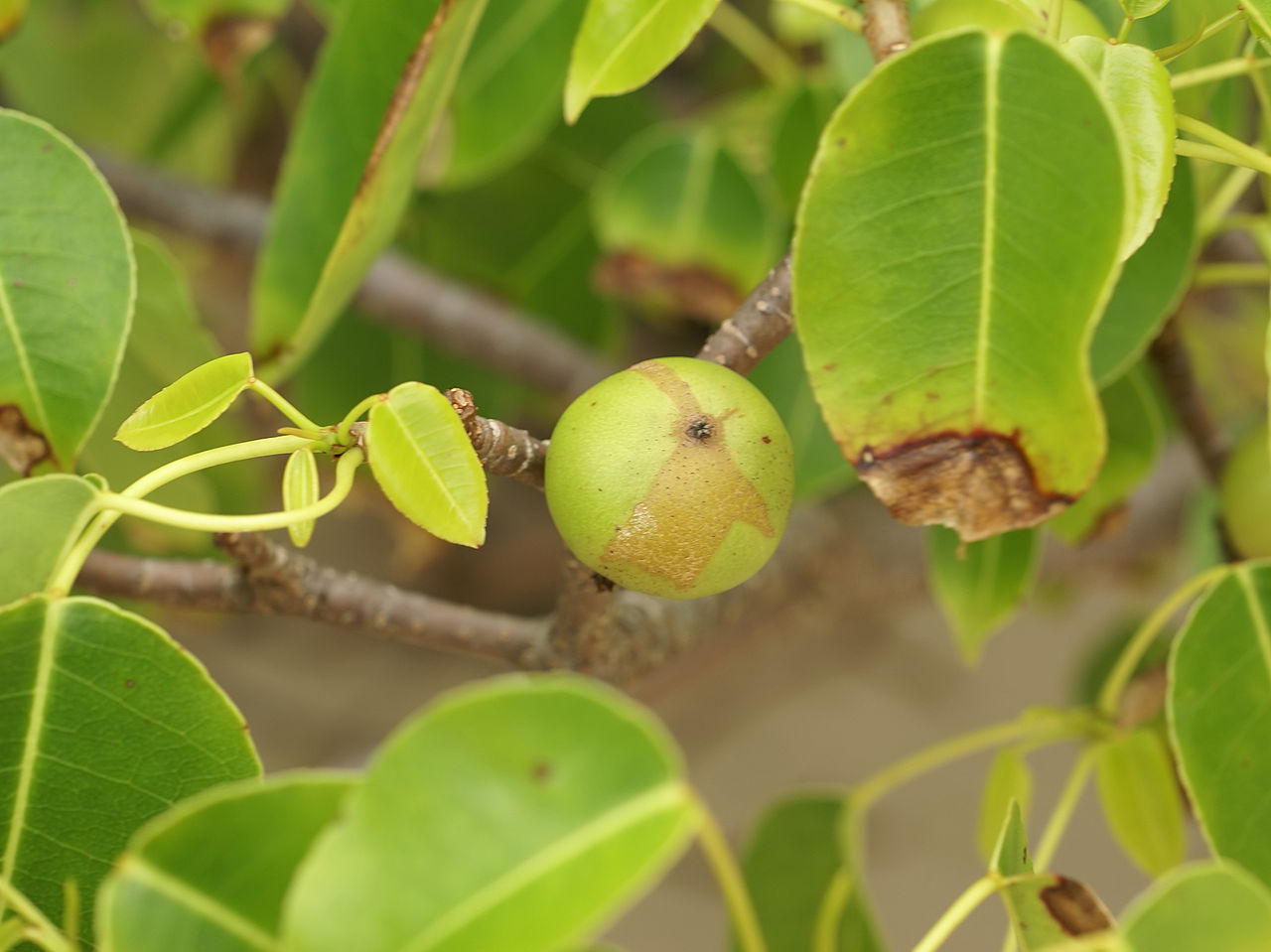Little Apple of Death

Fast Facts:
– Commonly known as the Manchineel tree
– Modern-day Spanish name is manzanilla de la muerte (little apple of death)
– Native to Caribbean, Florida (where it’s endangered), Bahamas, Central and northern South America
– One of the most toxic trees in the world
– Every part of the tree (bark, leaves, fruit) contains the toxic sap
– The fruit looks and tastes like a crabapple
– Spanish explorer, Juan Ponce de Leon, was killed with the sap
The Manchineel is a flowering tree from the spurge family (the same as Christmas poinsettia), which is found from the southern part of North America to the northern South Americas. The tree is found on beaches and brackish swamps (where you find mangroves) where it plays an important role in stabilising the sand and acting as a windbreak. In Spain it is known as the “little apple of death” due to it being one of the most toxic trees in the world. The milky-white sap contains numerous toxins and is found in every part of the tree, including the bark, leaves and fruit.
The sap is so dangerous, even standing under the tree in the rain will result in blistering skin… the water soluble sap in a small drop of rain in will cause burns. The sap even damages the paintwork on cars. If you burn the wood the smoke can cause eye damage. Consuming the apple can result in severe gastroenteritis, bleeding, shock and bacterial superinfection as well as a possible compromised airway, eventually killing through dehydration.

Some tribes used a poultice of arrowroot to treat poisonings, however no known antidote exists.
In parts of the world the trees carry a warning sign, or a red “X” on the trunk to indicate danger.
The black-spined iguana is the only known animal to be able to eat the fruit – they even live among the branches of the tree. Even though the tree is deadly, it’s been used by Caribbean furniture makers for centuries. The timber is cut and dried in the sub to remove the sap.
Even though the fruit is potentially fatal if eaten, there aren’t any modern day reports of death. One case of accidental consumption was reported in the British Medical Journal:
Moments later we noticed a strange peppery feeling in our mouths, which gradually progressed to a burning, tearing sensation and tightness of the throat. The symptoms worsened over a couple of hours until we could barely swallow solid food because of the excruciating pain and the feeling of a huge obstructing pharyngeal lump. Sadly, the pain was exacerbated by most alcoholic beverages, although mildly appeased by pina coladas, but more so by milk alone.
Nicola Strickland

From: Wikipedia
Apparently, it took over eight hours for the pain to slowly reduce (as they sipped their pina coladas and milk). Unfortunately the toxin drained into their neck lymph nodes providing further agony.
Historically it’s a different story. The poison was used by tribal people to poison the water supply of enemies (using the tree’s leaves). In 1521, Spanish explorer Juan Ponce de Leon died after a battling the Calusa in Florida. He was struck by an arrow poisoned with the sap of a Machineel tree.
Research:
https://www.sciencealert.com/do-not-stand-under-world-s-most-dangerous-tree-manchineel-tree
https://www.vice.com/en_us/article/qkj3e7/every-part-of-this-super-deadly-tree-can-kill-you-manchineel
https://en.wikipedia.org/wiki/Juan_Ponce_de_Le%C3%B3n
https://en.wikipedia.org/wiki/Manchineel

April 14, 2021 at 9:19 pm
Looks and tastes like a crab apple?! Eeeeppppp! When I was younger, I used the play down these abandoned rail tracks with my brother and friends and eat/climb on the crab apple trees there lol goodness!
Its nice that in some places they will identify the tree with an X lol how kind of them!
April 15, 2021 at 10:12 am
You know, I had to google what a crab apple was. I had always thought it was some special type of fruit, but turns out it is just a wild apple.
April 15, 2021 at 10:19 am
Haha yeah!
April 14, 2021 at 11:48 pm
I have never heard of this. I can’t wait to try some of these poisons in my next trilogy.
April 15, 2021 at 10:14 am
Yay, one you didn’t know. I almost feel like I have a mini challenge in trying to use poisons you aren’t aware of 🙂
April 15, 2021 at 4:09 am
The pina colada detail makes me laugh… Also, I now want to draw a black-spined iguana looking smug in the branches of a Manchineel tree.
April 15, 2021 at 10:20 am
I hadn’t thought it but yes, I can picture those smug iguanas, lol.
April 15, 2021 at 11:33 am
Wow. That’s a dangerous tree.
April 15, 2021 at 11:46 am
And you wouldn’t know it by looking at it. I’m surprised more places don’t label it as dangerous so there is less chance of accidental ingestion.
April 15, 2021 at 6:59 pm
This is why I dont eat things I don’t know about. Foraging both fascinates me and terrifies me. I don’t want to die from eating or being eaten.
April 16, 2021 at 3:20 pm
I would hate to get lost in the bush because knowing my luck I would probably die from eating the wrong thing.
April 15, 2021 at 8:24 pm
“Appeased by Piña Colada” – well, then! Bottoms up..!
I have never heard of this plant. Scary that even standing there in rainy weather may cause harm.
April 16, 2021 at 3:21 pm
Can you imagine if you didn’t know about the plant and you took shelter in the rain. You’d probably think it was acid rain!
April 15, 2021 at 11:32 pm
Seen a couple during fishing trips in the Glades. Almost all of them have red flagging tape tied to them, because of the high tourist trade in Florida fishing.
Randy Wayne White used it as an escape vehicle in one of his Hanna Smith stories. They are a l lot rarer than he made it seem like.
Odd thing going on here. I never got this yesterday, and the day before I had the K, and comments, on my phone hours before it came up on either my desktop or laptop. Same browser,Firefox, used on all three, strange.
April 16, 2021 at 3:26 pm
That is weird, BF. Technology is a strange beast.
Probably just as well they are rarer than in fiction.
April 16, 2021 at 8:56 am
Poisoned apple…a very Snow White vibe, that. Except for the iguanas, hah!
April 16, 2021 at 3:37 pm
That’s a really good comparison. I wonder if there was any inspiration for the Snow White story (perhaps the iguanas inspired the dwarves 🙂 )
April 18, 2021 at 12:22 am
There used to be tales about the upas tree with all these same sorts of descriptions – poisonous even to stand under it, etc – except it turns out the upas tree actually isn’t nearly that poisonous. It’s funny to find out that there really is a tree just with many of the attributes they described, but on a different continent.
Black and White: M for Middle-earth
April 18, 2021 at 7:50 am
I haven’t heard of the upas tree. I wonder if it looks like manchineel tree and that’s where the stories came from?